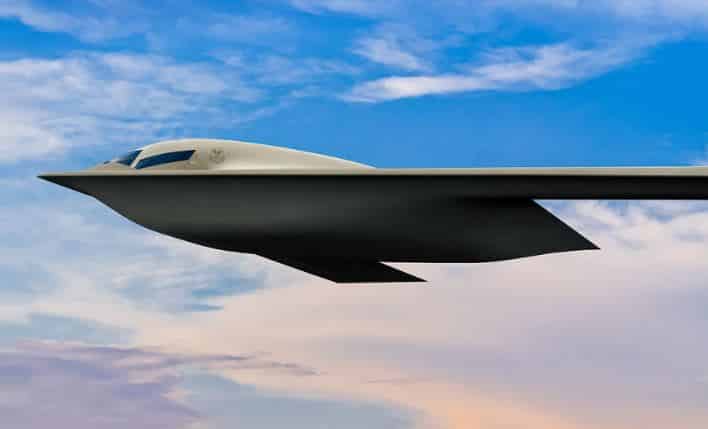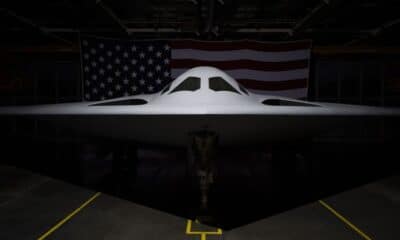Aerospace
10 Facts About Northrop Grumman’s B-21 Raider
The B-21 Raider, the first aircraft of the sixth generation in the world.

The B-21 Raider, the first aircraft of the sixth generation in the world, will be unveiled on December 2 at Northrop Grumman’s facility in Palmdale, California. When it is given to the Air Force, the B-21 will become a visible and adaptable deterrent that will assist national security goals and reassure the country’s allies and partners.
Northrop Grumman to Unveil the B-21 Raider(Opens in a new browser tab)
The Raider will give the Air Force extended range, excellent survivability, and mission payload flexibility when it comes to delivering America’s resolve. The B-21 can deliver precise strikes anywhere in the world despite the toughest defences. Here are the B-21 Raider’s ten most important characteristics.
Meet the Bell 360, the latest rival to the Sikorsky Raider X.(Opens in a new browser tab)
1. Sixth Generation. The B-21 Raider benefits from more than three decades of strike and stealth technology. It is the next evolution of the Air Force strategic bomber fleet. Developed with the next generation of stealth technology, advanced networking capabilities and an open systems architecture, the B-21 is optimized for the high-end threat environment. It will play a critical role in helping the Air Force meet its most complex missions.
2. Stealth. Northrop Grumman is continuously advancing technology, employing new manufacturing techniques and materials to ensure the B-21 will defeat the anti-access, area-denial systems it will face.
3. Backbone of the Fleet. The B-21 Raider forms the backbone of the future for U.S. air power. The B-21 will deliver a new era of capability and flexibility through advanced integration of data, sensors, and weapons. Capable of delivering both conventional and nuclear payloads, the B-21 will be one of the most effective aircraft in the sky, with the ability to use a broad mix of stand-off and direct attack munitions.
4. A Digital Bomber. The B-21 is a digital bomber. Northrop Grumman uses agile software development, advanced manufacturing techniques and digital engineering tools to help mitigate production risk on the B-21 program and enable modern sustainment practices. Six B-21 Raiders are in various stages of final assembly and test at Northrop Grumman’s plant in Palmdale, California.
5. Cloud Technology. Northrop Grumman and the Air Force successfully demonstrated the migration of B-21 ground systems data to a cloud environment. This demonstration included the development, deployment and test of B-21 data, including the B-21 digital twin, that will support B-21 operations and sustainment. This robust cloud-based digital infrastructure will result in a more maintainable and sustainable aircraft with lower-cost infrastructure.
6. Open Architecture. To meet the evolving threat environment, the B-21 has been designed from day one for rapid upgradeability. Unlike earlier generation aircraft, the B-21 will not undergo block upgrades. New technology, capabilities and weapons will be seamlessly incorporated through agile software upgrades and built-in hardware flexibility. This will ensure the B-21 Raider can continuously meet the evolving threat head on for decades to come.
7. A National Team. Since contract award in 2015, Northrop Grumman has assembled a nationwide team to design, test and build the world’s most advanced strike aircraft. The B-21 team includes more than 8,000 people from Northrop Grumman, industry partners and the Air Force. The team consists of more than 400 suppliers across 40 states.
8. Sustainment. Long-term operations and sustainment affordability has been a B-21 program priority from the start. In partnership with the Air Force, our team has made maintainability an equally important requirement to stealth performance to ensure we’re driving more affordable, predictable operations and sustainment outcomes.
9. Global Reach. The B-21 Raider will be the backbone of the U.S. bomber fleet and pivotal to supporting our nation’s strategic deterrence strategy. In addition to its advanced long-range precision strike capabilities that will afford Combatant Commanders the ability to hold any target, anywhere in the world at risk, it has also been designed as the lead component of a larger family of systems that will deliver intelligence, surveillance and reconnaissance, electronic attack and multi-domain networking capabilities. In a dynamic global security environment, the B-21 will provide the flexibility and deterrence critical to the security of the U.S. and our allies.
10. Raider. The B-21 Raider is named in honor of the Doolittle Raid of World War II when 80 airmen, led by Lt. Col. James “Jimmy” Doolittle, and 16 B-25 Mitchell medium bombers set off on a mission that changed the course of World War II. The actions of these 80 volunteers were instrumental in shifting momentum in the Pacific theater. This marked the raid as a catalyst to a multitude of future progress in U.S. air superiority from land or sea. The courageous spirit of the Doolittle Raiders is the inspiration behind the name of the B-21 Raider.
Fast Fact
- first aircraft in the world to use the newest 6th-generation technology.
- The aircraft is capable of being flown both manned and unmanned.
- To save money, it features a Pratt & Whitney F135 engine similar to the F-35.
- In service launch of the B-21 is anticipated for 2026 or 2027.
- It will eventually replace the B-2 Spirit and B-1 Lancer of the Air Force.
- For the USAF, it will be a long-range, covert intercontinental strategic bomber.
- It is capable of delivering nuclear and conventional weapons.
- It is remotely operative and has room for two crew.
- One B21 Raider could cost as much as $639 million.
- The USAF intended to purchase about 100 planes.
- It has a payload capacity of up to 30,000 pounds or 13607.771 kg
- 150 feet is the length of its wings.

Aerospace
Indigo will soon launch Air Taxi Service in India

InterGlobe Enterprises, the parent brand of IndiGo, is set to revolutionize travel in India with its upcoming air taxi service.
Scheduled for a potential launch in 2026, this innovative venture promises a seamless journey for passengers between two bustling hubs. Delhi and Gurgaon in Haryana. The forthcoming service is projected to revolutionize the daily commute, offering passengers a swift aerial journey covering the distance in a mere 7 minutes.
This remarkable efficiency contrasts starkly with the conventional 90-minute drive, underscoring the immense time-saving potential for commuters. The anticipated fare, ranging from Rs 2,000-3,000, makes this innovative mode of transport not only swift but also remarkably competitive in pricing.
At the heart of this ambitious endeavor lies a strategic partnership with Archer Aviation, a pioneer in electric vertical takeoff and landing (eVTOL) aircraft technology. Under this collaboration, Archer will supply 200 state-of-the-art eVTOL aircraft, representing an investment of US$ 1 billion. These cutting-edge aircraft, capable of accommodating up to four passengers alongside the pilot, epitomize the future of sustainable air travel.
Powered by six battery packs, Archer’s eVTOL aircraft boast rapid charging capabilities, enabling a swift turnaround between flights. With a charging time of just 30-40 minutes, these eco-friendly aircraft ensure minimal downtime, maximizing operational efficiency.
Similar services are anticipated to be introduced by the joint venture in Bengaluru and Mumbai as well. Nevertheless, the service rollout period has not yet been made public by the company. Next year, it is anticipated to get its certification. Following this, the company will start the certification procedure with the Directorate General of Civil Aviation (DGCA).
Aerospace
Which is bigger 777x or 787 aircraft ?

The 777X is a new series of the Boeing 777 family and is designed to be larger and more efficient than its predecessor. It features two variants: the 777-8 and the 777-9, being the larger of the two.
The Boeing 777X emerges as the larger sibling within the Boeing family, representing a significant leap forward in both size and efficiency. Comprising two variants, the 777-8 and the 777-9, the latter takes the crown as the larger of the two. With its expansive fuselage and impressive wingspan, the 777X is tailored for long-range journeys and boasts a substantial passenger capacity.
On the other hand, the Boeing 787, affectionately known as the Dreamliner, occupies a niche in the market as a smaller yet formidable aircraft designed for medium to long-range flights. Its distinguishing feature lies in its composite fuselage, a technological marvel that renders it lighter and more fuel-efficient compared to conventional aluminum counterparts. The Boeing 777X is larger than the Boeing 787 aircraft.
When it comes to passenger capacity, the 777-9 reigns supreme, typically accommodating a sizeable contingent of 400-425 passengers in its standard configuration. In contrast, the 787, with its more modest dimensions, typically carries between 240-290 passengers, depending on the variant and layout.
One of the remarkable innovations introduced with the 777X is its folding wingtips, a feature designed to address the logistical challenges of accommodating such a large aircraft in conventional airport gates. These folding wingtips enable the 777X to retract its wings, allowing it to fit into gates designed for smaller aircraft while still reaping the benefits of an extended wingspan during flight, thereby enhancing fuel efficiency and operational flexibility
Aerospace
China Secures Production Certificate for Mass Production of Pilotless eVTOL Aircraft

The first passenger-carrying pilotless electric vertical takeoff and landing (eVTOL) aircraft in the world, the EH216-S, has received the Production Certificate for its eVTOL aircraft from the Civil Aviation Administration of China (CAAC).
This is a significant milestone for EHang Holdings Limited, the leading UAM technology platform company in the world. This outstanding accomplishment is another big step towards mass manufacturing for the eVTOL aircraft and the ensuing commercial operations, building on the ground-breaking acquisition of the Type Certificate and the Standard Airworthiness Certificate for the EH216-S.
The PC is a crucial certificate that the aircraft maker receives from the CAAC, the country’s aviation authority. By obtaining this certificate, EHang has demonstrated that it has set up a quality management system for mass production that satisfies the airworthiness regulation standards set forth by the CAAC, and the company has been given permission to continue producing mass quantities.
It is also a strong guarantee of the calibre of the goods made by EHang. Raw materials, supplier management, manufacturing organisation, production quality control, aircraft pre-delivery test, after-sales repair and maintenance, etc. are all included in the mass production quality management system for the EH216-S.
To ensure that every aircraft and its components that roll off the production line strictly adhere to the approved type design and safety requirements, the system sets clear guidelines and documentation for every step in the production procedure. This ensures comprehensive traceability and safety control.
























